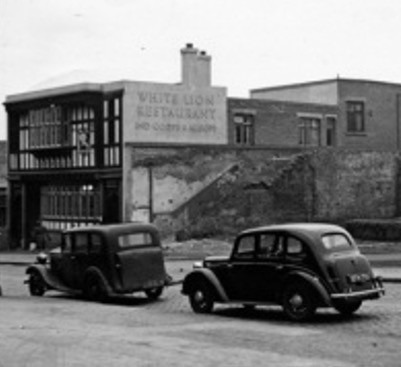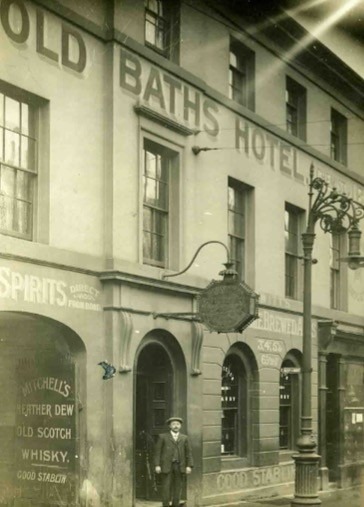Historian and CovSoc member, Peter James, tells us about the history of Smithford Street. Peter writes…..
Smithford Street once a key artery connecting Fleet Street to Broadgate played a vital role in the city’s development. In the 12th century travellers crossed the River Sherbourne at a ford known as Smythefford which existed between 1161 and 1175. By the 13th Century a bridge had replaced the ford making passage easier. From 1748 the structure would become known as Ram Bridge. Over the centuries a number of hotels and inns sprang up along this stretch of street.
The White Lion
The White Lion was already a prominent establishment by the 18th Century. In 1734 Susannah Wall the licensee was tragically robbed and murdered. The culprit was her nephew Thomas Wilday a wool comber who was subsequently tried found guilty and executed. His body hung in chains on Whitley Common as a grim warning. In 1860 the lease passed to Edward Shipman a veterinary surgeon as well as a publican. The licence eventually transferred to a building in Ironmonger Row in 1955, marking the end of its long tenure in Smithford Street.

The Leopard – 64 Smithford Street
The Leopard Inn was a notable public house that played a significant role in the social and civic life in the city. The name Leopard likely derived from the arms of the Weavers Company reflecting the area’s longstanding association with the industry. In 1761 The Leopard served as an Army Recruitment Office. By 1785 it was also used as an auction house, indicating its central position in Coventry’s community and commerce. Among its notable licensees was John “Fatty” Adrian the licensee between 1841 and 1843. A colourful figure who had previously been landlord of The Windmill in Spon Street, was also a prizefighter. His nickname “Fatty” did not relate to his physique but to an occasion when he climbed a pole covered in goose grease and won a suckling pig. The pub closed in 1938 when its licence was removed, Jackson the Tailor taking over the premises in 1939.
Old Baths Hotel – 35 Smithford Street
Opened in 1829 as The Bath Hotel the establishment quickly became a hub for travellers and locals alike. Its prime location made it especially popular with carriers travelling to Allesley and Meriden, who were attracted by the hotel’s well- kept stables and welcoming atmosphere.
Notable Licensees
In 1888 the hotel entered a new era under the stewardship of Jane Hitchins. Renamed the Old Baths Hotel it continued to thrive as an inn and social centre. By 1908 management had passed to Harry Hewitt who brought renewed energy and vision. Tragically Harry died young in January 1913 aged just 32. His dedicated partner Annie Green took over the reins managing the business through challenging times until 1915.
The Hewitt Legacy
The Hewitt family presence at the hotel coincided with another local enterprise, Harry who was the licensee in 1911 went into partnership with Frederick Kerby. They founded the Roulette Cycle Company who manufactured motorcycles at 84 Gosford Street. In 1951 with the redevelopment of Smithford Street, the hotels doors closed for the final time.

Kings Head Hotel
The Kings Head: A Historic Landmark
Number 3 Smithford Street has a rich history possibly originating as a site in the middle ages. The earliest recorded reference dates back to 1532 when William Lynde of the “Kynges Hed” payed rent to the Trinity Guild. By the eighteenth century the Kings Head had become a prominent coaching inn. Coaches departed every evening for London connecting Coventry with the capital. The inn gained further renown in the 19th Century hosting several important guests. Notably Lord Nelson accompanied by Sir William and Lady Hamilton and a party who arrived unexpectedly and stayed in 1802. Other illustrious visitors were the exiled Louis XVIII of France in 1808 and the Duke of Wellington in 1823.
The original structure was demolished in the 1870s to be replaced in 1879 by the King’s Head Hotel which extended into Hertford Street. This was the first time that the Peeping Tom statue appeared, situated on the fourth floor at the corner of the building.
Peeping Tom was brought inside the building in 1934, with plans to replace him with a replica. This never materialised. In 1940 the hotel was destroyed during the blitz, amazingly Peeping Tom survived and is now on display in the Godiva Gallery at the Herbert Museum.
In the post war period plans to rebuild Smithford Street were abandoned due to extensive wartime damage. Upper and lower precincts were built establishing pedestrian friendly zones connecting Fleet Street to Broadgate.
